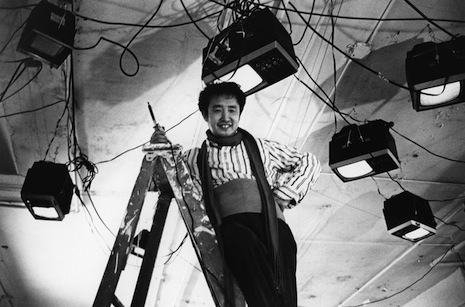
Beatles Electroniques, 1969
The relationship and eventual marriage of John Lennon and Yoko Ono, looked at from a slightly unusual perspective, can be seen as an alliance between the high pop mastery of the Beatles and the playful avant-garde methods of the Fluxus group. Ono was obviously one of the major Fluxus artists of the day, and in taking up with her Lennon exposed himself to avant-garde art in a particularly intimate way—and vice versa.
It would be a stretch to say that the Beatles were authentic pioneers of electronic music, but at the same time it couldn’t be clearer that McCartney and Co.’s relentless experimental incursions into the medium of pop music had an enormous effect on what was regarded as “in bounds” for rock music. The introduction of feedback on “I Feel Fine,” the use of reversed tape loops in “Tomorrow Never Knows,” the maelstrom of nonsense in “Revolution 9,” the symphonic collision of melody in “A Day in the Life,” and so on. In 1967 McCartney contributed a 14-minute tape loop composition called “Carnival of Light” to an awesome-sounding event called the The Million Volt Light and Sound Rave that has never reached the public even to this day (Harrison and George Martin loathed the piece; Harrison vetoed releasing it every chance he got). Meanwhile, Harrison himself made a key contribution to the canon of electronic music with the release of his second album, titled simply Electronic Sound, in 1969; the album consisted solely of two loooooooong Moog compositions, as my colleague Ron Kretsch ably explained on DM a few months back. Of course, Lennon himself was burrowing into weirdo musique concrete with Yoko, in various releases like Unfinished Music No. 2: Life with the Lions, Two Virgins, and Wedding Album.
Once dubbed “The Artist Who Invented Video Art,” Nam June Paik was an incredibly prolific and amusing conceptual artist from Korea in the postwar era; he is most associated with his works incorporating the cathode ray tube (we usually call it a TV set), including “TV-Buddha,” “TV Chair,” and “Family of Robot,” the last of which is essentially a series of robots made out of TV sets. Earlier in his career Paik was associated with John Cage, particularly his notorious 1960 work “Etude for Piano,” which culminated in Paik cutting off Cage’s necktie and washing Cage’s hair with shampoo.

The Beatles, 1969
In 1969 Paik teamed up with Fluxus-associated filmmaker Jud Yalkut to create Beatles Electroniques, a three-minute video in which Beatles footage is messed with electronically. I would argue that Beatles Electroniques is an essential proto-Plunderphonics text. I’m tempted to call it the first important Plunderphonics work in everything but name—the term “Plunderphonics” was coined by composer John Oswald in 1985 to describe works stretching back no earlier than the 1970s. Oswald’s key recordings include the Plunderphonics EP (1988) and the Plunderphonics album (1989). Key inheritors of the Plunderphonics style are Negativland and Christian Marclay. The Residents fucked with Beatles source material in The Beatles play The Residents and The Residents play The Beatles, but that was fully eight years after Beatles Electroniques.

Nam June Paik
As Barbara London’s essay “Looking at Music” described it in the volume Rewind, Play, Fast Forward: The Past, Present and Future of the Music Video,
In October 1965, Paik screened his first videotapes as part of a series of “happening nights” at the Greenwich Village nightclub Cafe au Go Go—a venue that included Lenny Bruce and the Grateful Dead among its roster of performers. … Beatles Electroniques, 1966-69, made with the experimental filmmaker Jud Yalkut, is nothing less than an early black-and-white music video. Paik grabbed bits from the mock documentary A Hard Day’s Night (directed by Richard Lester in 1964), refilming and further distorting the footage through his video synthesizer (developed with engineer Shuya Abe). Snippets of the Beatles’ faces are caught in a loop of warped abstraction. To accompany the endlessly folding imagery, Paik created a sound track with Kenneth Lerner, which featured fragmented Beatles songs recited again and again. Whereas the original film is an upbeat paean to Beatlemania, Paik’s strategies of appropriation and repetition are conceptually closer to Andy Warhol’s silk-screened paintings of celebrities such as Marilyn Monroe, 1962, and Steve Reich’s phasing of spoken words from a publicized racial incident in his sound composition Come Out (1966). Like these works, Beatles Electroniques brought seriality into the realm of sensory overload.
Nobody seems to know what these “fragmented Beatles songs” actually are, so transformed are they in Paik and Yalkut’s work. Without further ado, here’s Beatles Electroniques: